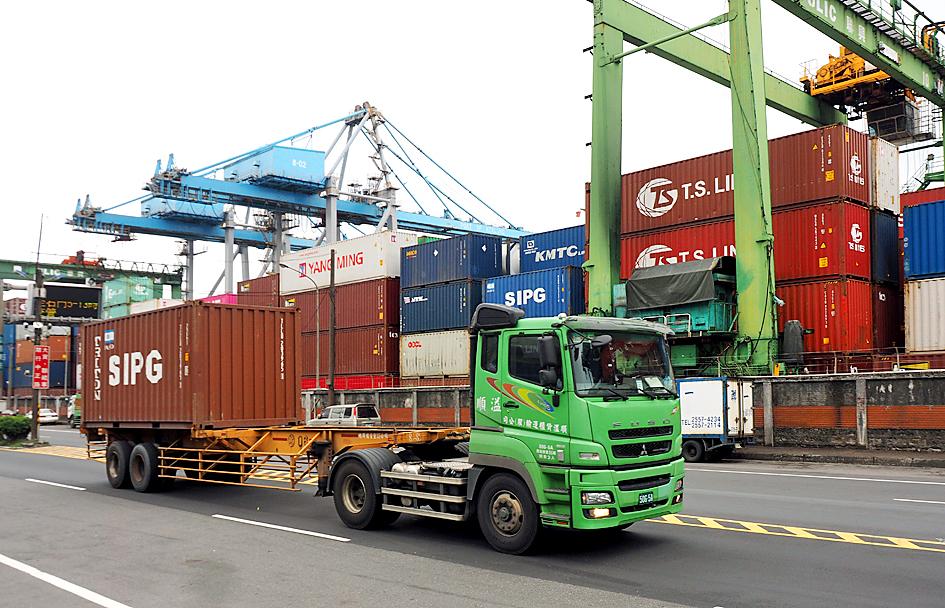The nation’s exports last month declined 2 percent year-on-year to US$27 billion, as cheaper crude oil prices dampened sales of products heavily reliant on raw materials, overshadowing shipments of electronic components, the Ministry of Finance said yesterday.
It was the third straight month the critical economic gauge remained negative and exports might not improve this month or even for the rest of this year, Department of Statistics Director-General Beatrice Tsai (蔡美娜) told a news conference in Taipei.
“The COVID-19 pandemic continued to weigh on sales of products using raw materials, as seen in a 57.3 percent plunge in exports of mineral products,” Tsai said.

Photo: David Chang, EPA-EFE
Likewise, shipments of base metals, plastic and chemical products dropped 15.2 percent, 19.9 percent and 15.6 percent year-on-year respectively, the ministry said in a report.
Exports of textile products slumped 35.1 percent, the second-worst fall since records began, as inventory remained high amid lockdowns in ASEAN and other markets, Tsai said.
However, shipments of electronic components continued to gain traction, logging a 13.2 percent increase to a record high of US$10.24 billion on fast-growing 5G deployment, as well as remote working and learning, she said.
Exports of semiconductors increased 14.2 percent to US$9.2 billion, while those of information and communications products rose 10.9 percent to US$3.95 billion, she said.
Remote learning and working from home might continue at many organizations and companies, boosting demand for data centers, servers and laptops, Tsai said.
Meanwhile, international technology giants pressed ahead with the launch of 5G wireless gadgets, despite the COVID-19 pandemic, providing business opportunities for local companies in their supply chains, she said.
“If the reopening of the economies in Europe and the US goes well, the electronics industry could perform better than expected in the second half of the year,” Singapore-based Barclays Bank PLC economist Angela Hsieh (謝涵涵) said.
“The biggest uncertainty comes from US-China relations, but the impact of that seems limited so far,” Hsieh added.
Exports to China and the US rose the most, gaining 10.6 percent and 9.3 percent respectively, while China accounted for 44.9 percent of overall exports, the ministry said.
Imports fell 3.5 percent to US$22.28 billion, mainly dragged down by cheaper crude oil prices that plummeted 63 percent year-on-year, Tsai said.
However, imports of capital equipment rose 14.2 percent to US$3.7 billion, as local firms, especially semiconductor makers, stood by their plans to upgrade and expand, she said.
The nation posted a trade surplus of US$4.72 billion for last month, a 5.6 percent increase from a year earlier.
The outlook is unlikely to become clear until global economies emerge from the pandemic, Tsai said, adding that exports would decline 2 to 5 percent this month.
That would suggest a decline in second-quarter exports from a year earlier.
In the first five months of this year, cumulative exports rose 1.5 percent to US$130.91 billion, while cumulative imports increased 1.4 percent to US$114.4 billion, creating a trade surplus of US$16.51 billion, the report showed.
Additional reporting by Bloomberg

CHIP RACE: Three years of overbroad export controls drove foreign competitors to pursue their own AI chips, and ‘cost US taxpayers billions of dollars,’ Nvidia said China has figured out the US strategy for allowing it to buy Nvidia Corp’s H200s and is rejecting the artificial intelligence (AI) chip in favor of domestically developed semiconductors, White House AI adviser David Sacks said, citing news reports. US President Donald Trump on Monday said that he would allow shipments of Nvidia’s H200 chips to China, part of an administration effort backed by Sacks to challenge Chinese tech champions such as Huawei Technologies Co (華為) by bringing US competition to their home market. On Friday, Sacks signaled that he was uncertain about whether that approach would work. “They’re rejecting our chips,” Sacks

NATIONAL SECURITY: Intel’s testing of ACM tools despite US government control ‘highlights egregious gaps in US technology protection policies,’ a former official said Chipmaker Intel Corp has tested chipmaking tools this year from a toolmaker with deep roots in China and two overseas units that were targeted by US sanctions, according to two sources with direct knowledge of the matter. Intel, which fended off calls for its CEO’s resignation from US President Donald Trump in August over his alleged ties to China, got the tools from ACM Research Inc, a Fremont, California-based producer of chipmaking equipment. Two of ACM’s units, based in Shanghai and South Korea, were among a number of firms barred last year from receiving US technology over claims they have

BARRIERS: Gudeng’s chairman said it was unlikely that the US could replicate Taiwan’s science parks in Arizona, given its strict immigration policies and cultural differences Gudeng Precision Industrial Co (家登), which supplies wafer pods to the world’s major semiconductor firms, yesterday said it is in no rush to set up production in the US due to high costs. The company supplies its customers through a warehouse in Arizona jointly operated by TSS Holdings Ltd (德鑫控股), a joint holding of Gudeng and 17 Taiwanese firms in the semiconductor supply chain, including specialty plastic compounds producer Nytex Composites Co (耐特) and automated material handling system supplier Symtek Automation Asia Co (迅得). While the company has long been exploring the feasibility of setting up production in the US to address

OPTION: Uber said it could provide higher pay for batch trips, if incentives for batching is not removed entirely, as the latter would force it to pass on the costs to consumers Uber Technologies Inc yesterday warned that proposed restrictions on batching orders and minimum wages could prompt a NT$20 delivery fee increase in Taiwan, as lower efficiency would drive up costs. Uber CEO Dara Khosrowshahi made the remarks yesterday during his visit to Taiwan. He is on a multileg trip to the region, which includes stops in South Korea and Japan. His visit coincided the release last month of the Ministry of Labor’s draft bill on the delivery sector, which aims to safeguard delivery workers’ rights and improve their welfare. The ministry set the minimum pay for local food delivery drivers at